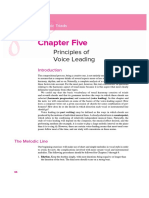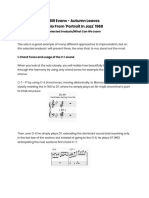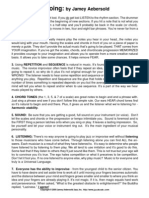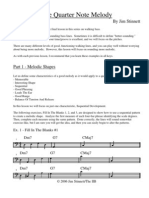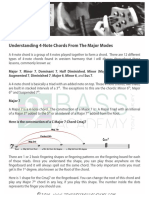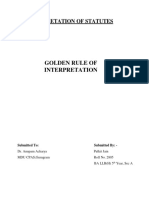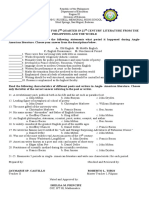Soloing and Vamping
Soloing and Vamping
Uploaded by
api-3832119Copyright:
Available Formats
Soloing and Vamping
Soloing and Vamping
Uploaded by
api-3832119Original Description:
Copyright
Available Formats
Share this document
Did you find this document useful?
Is this content inappropriate?
Copyright:
Available Formats
Soloing and Vamping
Soloing and Vamping
Uploaded by
api-3832119Copyright:
Available Formats
IMPROVISING AND SOLOING
O tonceapply
you've learned a few of the scales in this book in various positions on the neck, you may start wondering how
them to songs. Here are a few tips:
Major and Minor Keys
Keys are a great way to approach soloing and improvising because they allow you to choose one scale for a whole "
song (or progression) and stick with it, rather than picking a new scale for every chord. If a song or progression is in
a major key, use the corresponding major scale (e.g., C major for the key of C) or its pentatonic version. If a song is
in a minor key, use the natural minor scale or the minor pentatonic. To decode a song's key, try plugging its chords
into the chart below. All the chords should fit horizontally into one of the rows. If a song is in C major, for example, it
will use some or all of the chords in the first row, with an emphasis on the I ("one") chord, C. If a song is in A minor,
it will likewise make use of chords in the first row, but with an emphasis on the vi ("six") chord, Am. (NOTE: Some
songs go through more than one key, in which case you'll need to use more than one scale in your soloing.)
Modes If a song's chords fit into one of the rows above, but a chord other than the I or vi is emphasized, the song may be
in a mode. In that case, look along the bottom of the chart above to find the mode that corresponds with the
emphasized chord. For example, if a song uses chords from the top row, but Dm is clearly the main, or "tonic,"
chord (e.g., Dm-G-Am-Dm), try soloing with the D Dorian mode.
The Chord-by-Chord Approach
If a chord progression moves slowly, or if a song lingers primarily on just one chord, you may want to opt for a
chord-by-chord approach to soloing. In that case, simply determine the quality of the chord over which you're
playing—major, minor, etc.—and apply whatever scale or mode fits its basic structure. You can even try alternat-
ing between different scale types.
Chord type Formula Scale Mode
Major Major, major pentatonic, blues Ionian, Lydian, Mixolydian
Minor ; '. Minor, minor pentatonic, blues Dorian, Phrygian, Aeolian
Diminished Diminished Locrian
Augmented Whole tone
Major 7th Major, major pentatonic Ionian, Lydian
Minor 7th Minor, minor pentatonic Dorian, Phrygian, Aeolian
Dominant 7th Blues, Mixo-blues Mixolydian
Always keep this in mind: Scales and modes aren't usually played from root to root; this is just the way they're
You might also like
- The Charles F. Stanley Life Principles Daily BibleDocument33 pagesThe Charles F. Stanley Life Principles Daily BibleThomas Nelson Bibles83% (6)
- Tonal Harmony - Stefan Kostka - Chapter 5 - Principles of Voice LeadingDocument15 pagesTonal Harmony - Stefan Kostka - Chapter 5 - Principles of Voice LeadingYayi Wira PamungkasNo ratings yet
- Bill Evans - Autumn Leaves Solo From Portrait in Jazz' 1960Document3 pagesBill Evans - Autumn Leaves Solo From Portrait in Jazz' 1960Cedric TutosNo ratings yet
- Modal Interchange DocumentDocument1 pageModal Interchange Documentgolf12345No ratings yet
- Chord How It's Formed ResolutionDocument4 pagesChord How It's Formed ResolutionDaniel AgiusNo ratings yet
- Chord ExtensionsDocument2 pagesChord ExtensionsdixitbhattaNo ratings yet
- Embellished ArpeggiosDocument1 pageEmbellished ArpeggiosPete Sklaroff100% (1)
- Slash ChordDocument4 pagesSlash ChordMohd Yusri HamidNo ratings yet
- Source 2Document8 pagesSource 2Miguel Marques100% (1)
- 04 SoloingDocument1 page04 Soloingsuzytwo100% (1)
- Picture Chord Encyclopedia: Jermaine GriggsDocument16 pagesPicture Chord Encyclopedia: Jermaine GriggsVincentBMorrisNo ratings yet
- Diminished Scale & Double Diminished Chord - The Jazz Piano SiteDocument6 pagesDiminished Scale & Double Diminished Chord - The Jazz Piano Sitegeorge moogNo ratings yet
- MSessions 2006-02 Reharmonization Secrets Part 1Document4 pagesMSessions 2006-02 Reharmonization Secrets Part 1윤여일No ratings yet
- Learn How To Play The Jazz 251 Chord Progression On Piano!Document4 pagesLearn How To Play The Jazz 251 Chord Progression On Piano!abel habtamuNo ratings yet
- How To Really Play The Piano 32 PDFDocument1 pageHow To Really Play The Piano 32 PDFPiano Pour TousNo ratings yet
- Giant Steps SoloDocument12 pagesGiant Steps SolozeppeliinNo ratings yet
- Harmonic Minor ScaleDocument3 pagesHarmonic Minor ScaleBernard MarxNo ratings yet
- Rearmonizacion James WalkerDocument29 pagesRearmonizacion James WalkerNorberto MontozziNo ratings yet
- Major Scale FingeringDocument2 pagesMajor Scale Fingeringjonathan kpoviessiNo ratings yet
- QNMDocument10 pagesQNMMark BrewerNo ratings yet
- Backcycling Music TheoryDocument5 pagesBackcycling Music TheorysuriyaprakashNo ratings yet
- Voicing: Vocal RangesDocument3 pagesVoicing: Vocal Rangesnkovi0% (1)
- Walking Bass LinesDocument6 pagesWalking Bass LinestondeeeNo ratings yet
- Modal Interchange Lesson PDFDocument1 pageModal Interchange Lesson PDFמעיין חייטNo ratings yet
- Chord Scales - Comparative ChartDocument4 pagesChord Scales - Comparative ChartSergio XcaerNo ratings yet
- Altered Dominants: The Polytonal Approach: Diminished HarmonyDocument5 pagesAltered Dominants: The Polytonal Approach: Diminished HarmonyMattiaNo ratings yet
- Let's Stay Together - EDocument1 pageLet's Stay Together - ERafael SemtchukNo ratings yet
- Learn To Play by Ear Demo PDFDocument116 pagesLearn To Play by Ear Demo PDFSalvador PennaNo ratings yet
- Tims Pentatonic 1Document24 pagesTims Pentatonic 1bottom2x100% (1)
- Basic Harmony PDFDocument1 pageBasic Harmony PDFAlex HillNo ratings yet
- Chord FormulaeDocument6 pagesChord FormulaevinuyeNo ratings yet
- Harmon IzationDocument4 pagesHarmon IzationIván BuchannonNo ratings yet
- Introduction To Chord ConstructionDocument2 pagesIntroduction To Chord ConstructionfabregatNo ratings yet
- Chorwarmharp PDFDocument5 pagesChorwarmharp PDFMarcos César Viana100% (1)
- 2-5-1s (3rds & 7ths)Document1 page2-5-1s (3rds & 7ths)Paul WatsonNo ratings yet
- Custom Modal Pentatonic ScalesDocument5 pagesCustom Modal Pentatonic ScalesWayne WhiteNo ratings yet
- All About The Diminished Chord - Simplifying TheoryDocument7 pagesAll About The Diminished Chord - Simplifying Theorylokki33No ratings yet
- Lesson 11 - The Iim7b5 - V7 - Im Chord ProgressionDocument11 pagesLesson 11 - The Iim7b5 - V7 - Im Chord ProgressionDomenico RaffaNo ratings yet
- Inversion (Music) - WikipediaDocument10 pagesInversion (Music) - WikipediaDiana GhiusNo ratings yet
- A Map of The Interconnection Between Keys: Fractal Key of That NoteDocument1 pageA Map of The Interconnection Between Keys: Fractal Key of That NoteJohn Arturo Talavera MendozaNo ratings yet
- Notes For Comp ExamDocument8 pagesNotes For Comp ExammikeNo ratings yet
- 58 Secondary DominantsDocument5 pages58 Secondary DominantsBruno Timarchi YnoñánNo ratings yet
- 4 PGDocument3 pages4 PGJunior CelestinusNo ratings yet
- Diminshed Chords TheoryDocument11 pagesDiminshed Chords TheoryParthiban50% (2)
- 9 Triad Pairs That Sound GreatDocument4 pages9 Triad Pairs That Sound GreatsaoblackdenovoNo ratings yet
- Fender Players Club: C Whole Tone ScaleDocument4 pagesFender Players Club: C Whole Tone ScalefistfullofmetalNo ratings yet
- Cosas Chopin EtudesDocument5 pagesCosas Chopin EtudesDaniel GregorioNo ratings yet
- Augmented Sixth ChordDocument11 pagesAugmented Sixth ChordVictorSmerkNo ratings yet
- DoDOMINANT CHORD TRIAD PAIRSminant Chord Triad PairsDocument1 pageDoDOMINANT CHORD TRIAD PAIRSminant Chord Triad Pairsedwhite18No ratings yet
- James Graydon - (20 Acoustic Jazzy Blues Lick)Document2 pagesJames Graydon - (20 Acoustic Jazzy Blues Lick)Thiaguinho MirandaNo ratings yet
- Understanding 4+Note+Chords From+the+Major+ModesDocument10 pagesUnderstanding 4+Note+Chords From+the+Major+ModesAnonymous mowzCsSNo ratings yet
- Augmented Sixth ChordsDocument4 pagesAugmented Sixth ChordsFahma MolNo ratings yet
- Jazz Standards Autumn Leaves Progression A26Document1 pageJazz Standards Autumn Leaves Progression A26GHlogNo ratings yet
- Theory: JPS Podcast 69 - The JPS SystemDocument4 pagesTheory: JPS Podcast 69 - The JPS SystemAlejandro ÁlvarezNo ratings yet
- 1 SetClasses PDFDocument10 pages1 SetClasses PDFGuilherme Vinícius Rigatto100% (1)
- Chord/Scale Theory Chord/Scale Theory: Cmaj7 Cmaj7 C C 7 7Document1 pageChord/Scale Theory Chord/Scale Theory: Cmaj7 Cmaj7 C C 7 7Pete SklaroffNo ratings yet
- (Re) Thinking ImprovisationDocument2 pages(Re) Thinking ImprovisationRui LeiteNo ratings yet
- Laitz-CommonToneChords CTdim7 and CTaug6Document3 pagesLaitz-CommonToneChords CTdim7 and CTaug6tevo5555No ratings yet
- Philip “Flip” Gordon : Jazz Compositions: Volume 1: The Zodiac Project: Parallel UniverseFrom EverandPhilip “Flip” Gordon : Jazz Compositions: Volume 1: The Zodiac Project: Parallel UniverseNo ratings yet
- (MS-CUSTOMUI) - Editbox (Edit Box) - Microsoft LearnDocument15 pages(MS-CUSTOMUI) - Editbox (Edit Box) - Microsoft Learnwmca28No ratings yet
- FS Enhancement Template04-167MM - Marchon AMSDocument20 pagesFS Enhancement Template04-167MM - Marchon AMSashishsapmmNo ratings yet
- 1999 Lapackuser'guideDocument435 pages1999 Lapackuser'guideMichael ChenNo ratings yet
- Activity Template Product BacklogDocument2 pagesActivity Template Product BacklogHello KittyNo ratings yet
- Golden Rule of InterpretationDocument11 pagesGolden Rule of InterpretationManishaNo ratings yet
- Propellerhead Brand ManualDocument76 pagesPropellerhead Brand Manualrmiranda_884531No ratings yet
- Unit 2: City Life: A. B. C. D. A. B. C. D. A. B. C. DDocument4 pagesUnit 2: City Life: A. B. C. D. A. B. C. D. A. B. C. Danh trầnNo ratings yet
- Friedrich Wilhelm NietzscheDocument11 pagesFriedrich Wilhelm Nietzschejsus22No ratings yet
- Fourthsummative Test For 2ND Quarter in 21ST Century Literature From The Philippines and The WorldDocument1 pageFourthsummative Test For 2ND Quarter in 21ST Century Literature From The Philippines and The WorldErwin CastilloNo ratings yet
- Linear Equation in Two Variables by Rudra RawatDocument9 pagesLinear Equation in Two Variables by Rudra RawatAparna RawatNo ratings yet
- The Inarticulate Nymph and The Eloquent KingDocument14 pagesThe Inarticulate Nymph and The Eloquent Kinghari haraNo ratings yet
- Creating A Standard XStep For A PI SheetDocument4 pagesCreating A Standard XStep For A PI SheetSuresh NayakNo ratings yet
- Cve 253 Real Lecture Note-1Document45 pagesCve 253 Real Lecture Note-1redni907No ratings yet
- Rotten Bananas Hip Hop Heads and The American IndividualDocument21 pagesRotten Bananas Hip Hop Heads and The American Individual梧桐No ratings yet
- Fce Writing DossierDocument12 pagesFce Writing DossierCristina Fernández Díaz100% (1)
- Double Vision - Mcluhan's Contributions To Media As An Interdisciplinary Approach To Communication, Culture, and TechnologyDocument24 pagesDouble Vision - Mcluhan's Contributions To Media As An Interdisciplinary Approach To Communication, Culture, and TechnologyNickyNo ratings yet
- Christmas Assembly Compere ScriptDocument3 pagesChristmas Assembly Compere Scriptsherel.dsouzaNo ratings yet
- 2016 Corporate PresentationDocument40 pages2016 Corporate PresentationselmuxgroupNo ratings yet
- (Edited) NO Forum EthicsDocument2 pages(Edited) NO Forum EthicsArtemio Entendez IINo ratings yet
- SAAD Lecture I - IntroductionDocument36 pagesSAAD Lecture I - IntroductionKisyenene JamusiNo ratings yet
- 300-435 ENAUTO 01 (Autosaved)Document148 pages300-435 ENAUTO 01 (Autosaved)CafuNo ratings yet
- What Is Om EbookDocument18 pagesWhat Is Om Ebookalka vijhNo ratings yet
- Introducción Al Monte CarloDocument20 pagesIntroducción Al Monte CarloCesar Miranda PérezNo ratings yet
- Unit 2 - Designing Computer Based Method & Procedures Control & Designing Structured Programs - 5!1!10Document30 pagesUnit 2 - Designing Computer Based Method & Procedures Control & Designing Structured Programs - 5!1!10kannans110No ratings yet
- A Gentle Introduction To InequalitiesDocument30 pagesA Gentle Introduction To InequalitiesMOLDOVEANU SEVERIUSNo ratings yet
- Central Hindu School Class 6th Exam: Model Paper SetDocument13 pagesCentral Hindu School Class 6th Exam: Model Paper SetVikas ChaudharyNo ratings yet
- Questions Minoan MycenaeanDocument1 pageQuestions Minoan MycenaeanGeraldine QuirogaNo ratings yet
- Rauhut 2004 GenyodectesDocument10 pagesRauhut 2004 GenyodectesMaurício GarciaNo ratings yet
- English 8 Week 1 DLLDocument4 pagesEnglish 8 Week 1 DLLJenilyn BalangonNo ratings yet

